What Is Zero Force Member for Truss | How to Identification of Zero Force Members in Truss
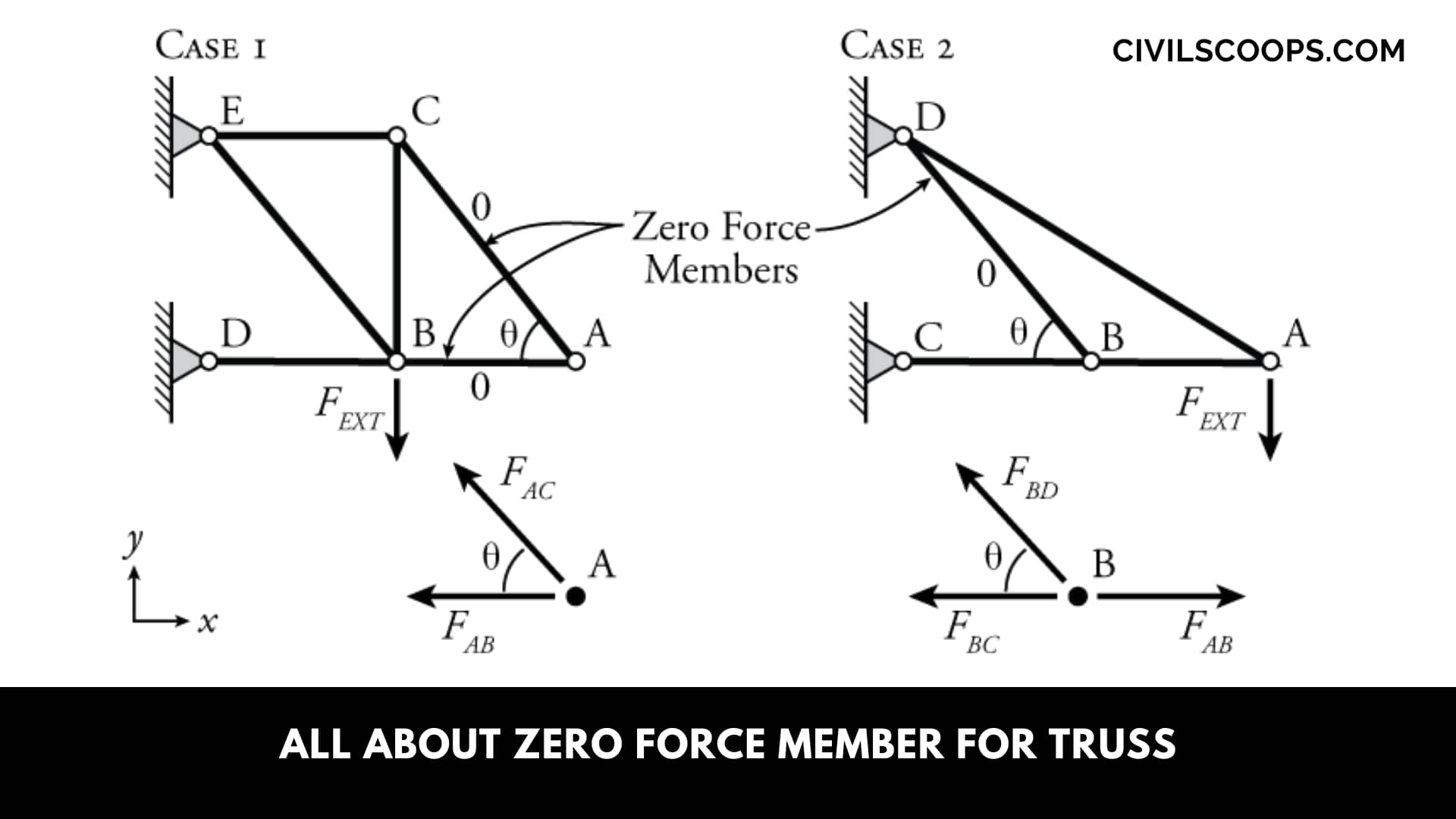
Table of Contents
What Is Zero Force Member?

In a truss system, some members are not carrying any force. This called a zero-force member.
This member may be added to increase truss stability. Identifying these members will simplify the process of analyzing truss.
What Is Zero Force Member for Truss?
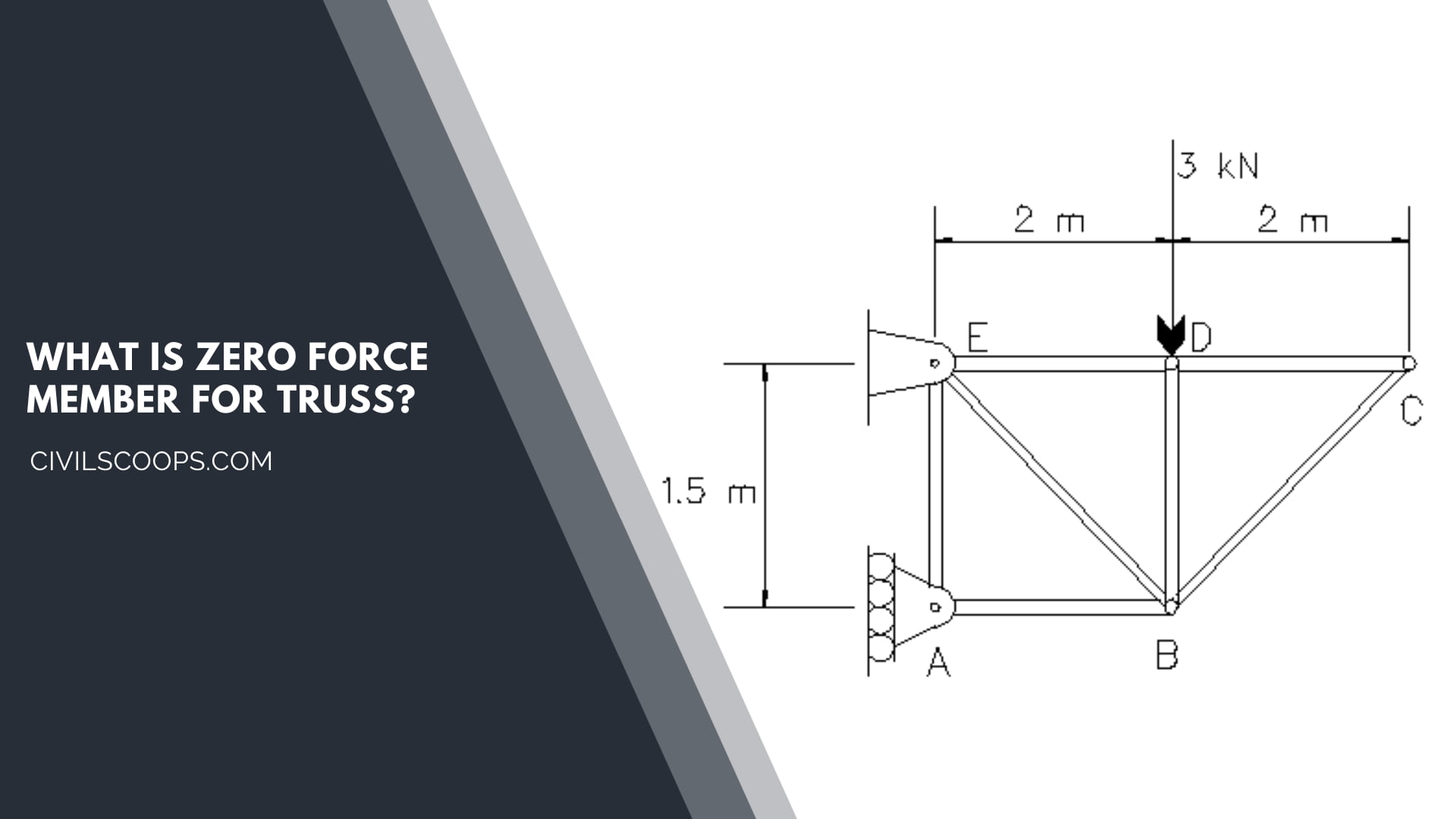
Truss analysis using the method of joints is greatly simplified if one is able to first determine those members that support no loading.
These zero force members may be necessary for the stability of the truss during construction and to provide support if the applied loading is changed.
The zero-force members of a truss can generally be determined by inspection of the joints, and they occur in two cases.
Useful Article for You
- What Is a Highway Flyover
- What Is Grouting
- What Is a Pile Cap
- What Is a Bond Beam in Masonry
- What Is Sapwood
- What Is Crane
- What Is a Gable
- What Is Superelevation
- What Is Kerb
- What Is the Purpose of Washers
- What Is the Size of a Brick in Inches
- What Is Reinforced Masonry
- What Is Workability
- What Is Bond Breaker
- What Is Plasticizer in Concrete
- What Is Luminous Flux Vs Lumens
- What Is Caisson
- What Is an Undercoat
- What Is a Benchmark Surveying
- What Is Bracing in Construction
- What Is a Beam in Construction
- What Is the Standard Door Frame Size
- What Is a Spandrel Beam
- What Is a Fire Escape
- What Is a Weep Hole
- What Is Tie Beam
- What Is Fine Aggregate
- What Is Pony Wall
- What Is Flag Stone
- What Is Development Length
- What Is Cement Plaster
- What Is a Pitched Roof
- What Is a Slab in Construction
- What Is a Monolithic Slab
- What Is Linear Distance
- What Is Shovel
- What Is Lintel in Construction
- What Is a Concept Sketch
- What Is Mezzanine Floor
- What Is Man Sand
- What Is Plaster Made Out of
- What Is a Floating Slab
- What Is Falsework
- What Is Bituminous
- What Is a Spillway
- What Is Curb and Gutter
- What Is Dampness
- What Is Lap Length
- What Is the Full Form of Fsi
- What Is Door Frame
- What Is Plinth Protection
- What Is Traffic Rotary
- What Is Grade Slab
- What Is Inverted Beam
- What Is Rolling Margin of Steel
- What Is Modulus of Rupture
- What Is Fresh Concrete
- What Is Dpc in Construction
- What Is Earthen Dam
Case – 1.
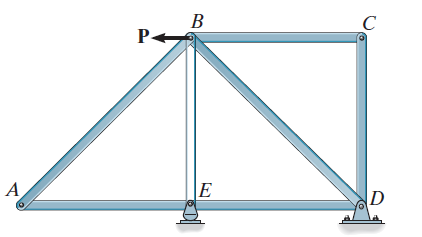
Consider the truss in above Fig -1 (Truss). The two members at joint “C” are connected together at a right angle and there is no external load on the joint.
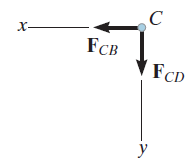
Truss Joint – Fig – 2.
The free-body diagram of joint “C”, Fig – 2 (Truss Joint), indicates that the force in each member must be zero in order to maintain equilibrium.

Truss Joint – Fig – 3.
Furthermore, as in the case of joint “A”, Fig – 3 (Truss Joint) this must be true regardless of the angle say θ. between the members.
Case – 2.
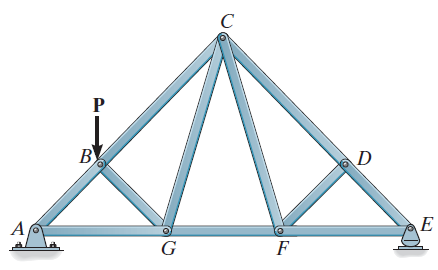
Truss Fig – 4.
Zero-force members also occur at joints having a geometry as joint “D” in above fig -4 (Truss).
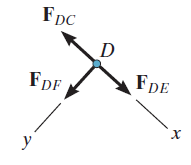
Truss Joint – Fig – 5.
Here no external load acts on the joint, so that a force summation in the y-direction, Fig – 5 (Truss Joint), which is perpendicular to the two collinear members, requires that FDF = 0.

Truss Joint – Fig – 6.
Using this result. “FC” is also a zero-force member, as indicated by the force analysis of joint “F”, Fig – 6 (Truss Joint).3
Also Read: All About Prismatic Compass Surveying
Summary of Zero Force Member for Truss
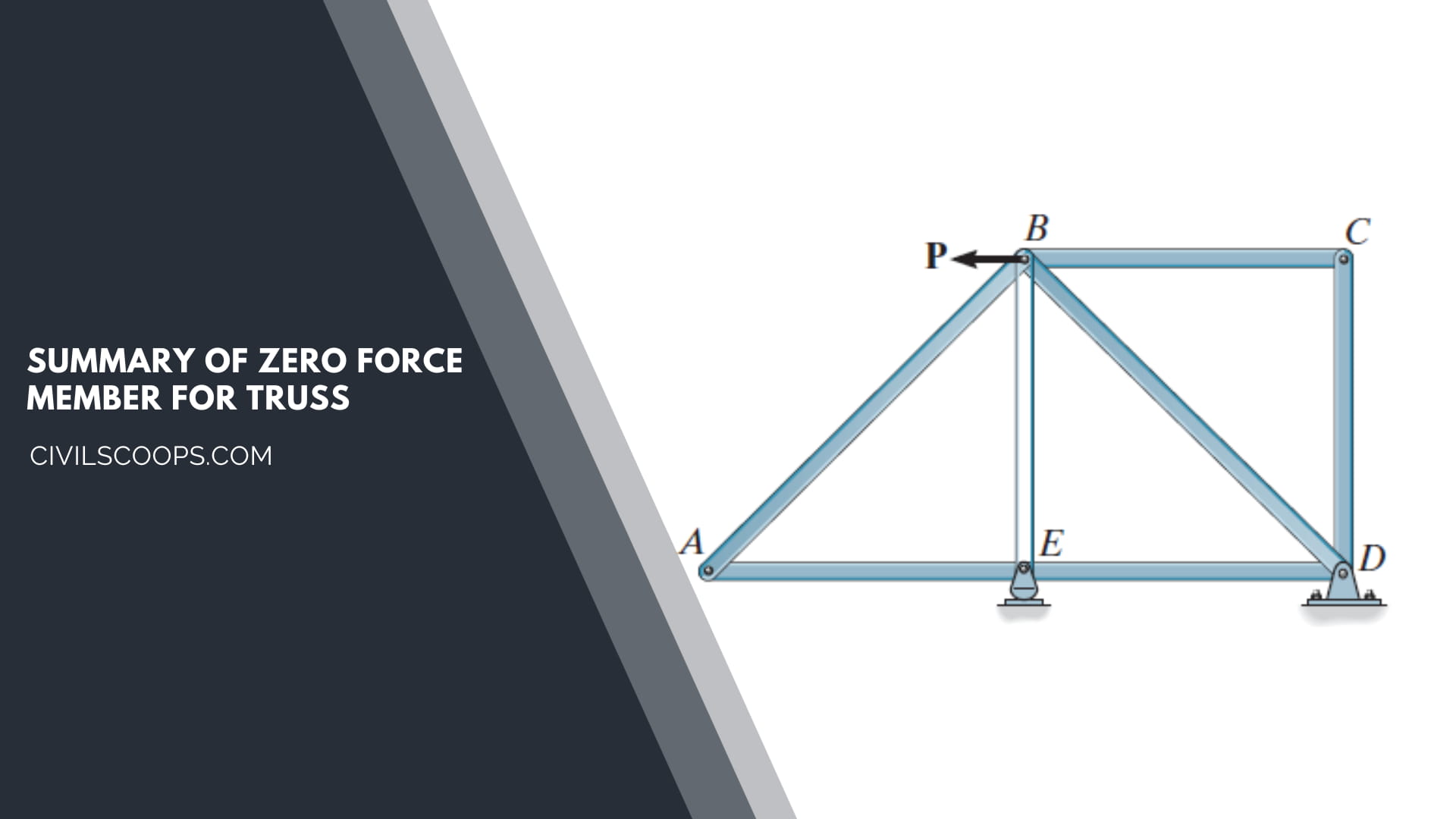
Then, if only two non-collinear members form a truss joint and no external load or support reaction is applied to the joint, the members must be zero-force members, Case 1.
Also, if three members form a truss joint for which two of the members are collinear, the third member is a zero-force member, provided no external force or support reaction is applied to the joint, Case 2.
Particular attention should be directed to these conditions of joint geometry and loading. since the analysis of a truss can be considerably simplified by first spotting the zero-force members.
Useful Article for You
- How Wide Is a Cinder Block
- How Much Is a Coffered Ceiling
- How to Make Mortar
- How Long Does Hempcrete Last
- How to Use a Hand Sight Level
- How to Construction
- How to Build a Lean to Roof
- How Are Tunnels Built
- How to Layout a Building
- How Wide Is a Car Parking Space
- How Do Shear Walls Work
- How to Measure Concrete Slump
- How Are Bridge Foundations Built
- How to Use Washers with Screws
- How Dense Is Sand
- How High Is a Window from the Floor
- How to Fix Spalling Concrete Foundation
- How Does a Beam Bridge Work
- How Do They Pour Concrete Under Water
- How Does a Sewer System Work
- How High Are Countertops
- How to Seal Brick Wall Interior
- How to Resurface Cement
- How to Use Portland Cement
- How Is Plaster Made
- How to Find Fineness Modulus
- How to Get Rid of Spray Paint Smell on Metal
- How Many Types of Slope Are There
- How Big Is a Stair Landing
- How Does Rebar Help Concrete
- How to Get Paint Off Concrete Without Chemicals
- How to Fix Water Damaged Drywall
- How Much to Get Septic Pumped
- How to Cut a Nail or Screw
- How Long Does Wet Concrete Take to Dry
- How Is Varnish Made
- How Does Ejector Pump Work
- How Does Hydrometer Work
- How to Get Wet Blood Out of Carpet
- How to Build House on Slope
- How Thick Is Plaster Wall
- How Suspension Bridges Work
- How to Seal a Concrete Roof
- How Was Cement Invented
- How to Calculate Area of Steel
- How to Check Silt Content in Sand
- How a Building Is Constructed
- How Are Roads Classified in India
- How Many Types of Cement in India
- How to Find Contour Interval
- How to Stop Leakage from Ceiling
- How Hardness of Brick Is Tested
- How Many Types of Paint Brushes Are There
- How to Calculate Skirting Area
- How Many Types of Beam
- How to Make Road
- How Many Types of Chain in Surveying
- How to Calculate Weight of Steel Bar
How to Identification of Zero Force Members in Truss?
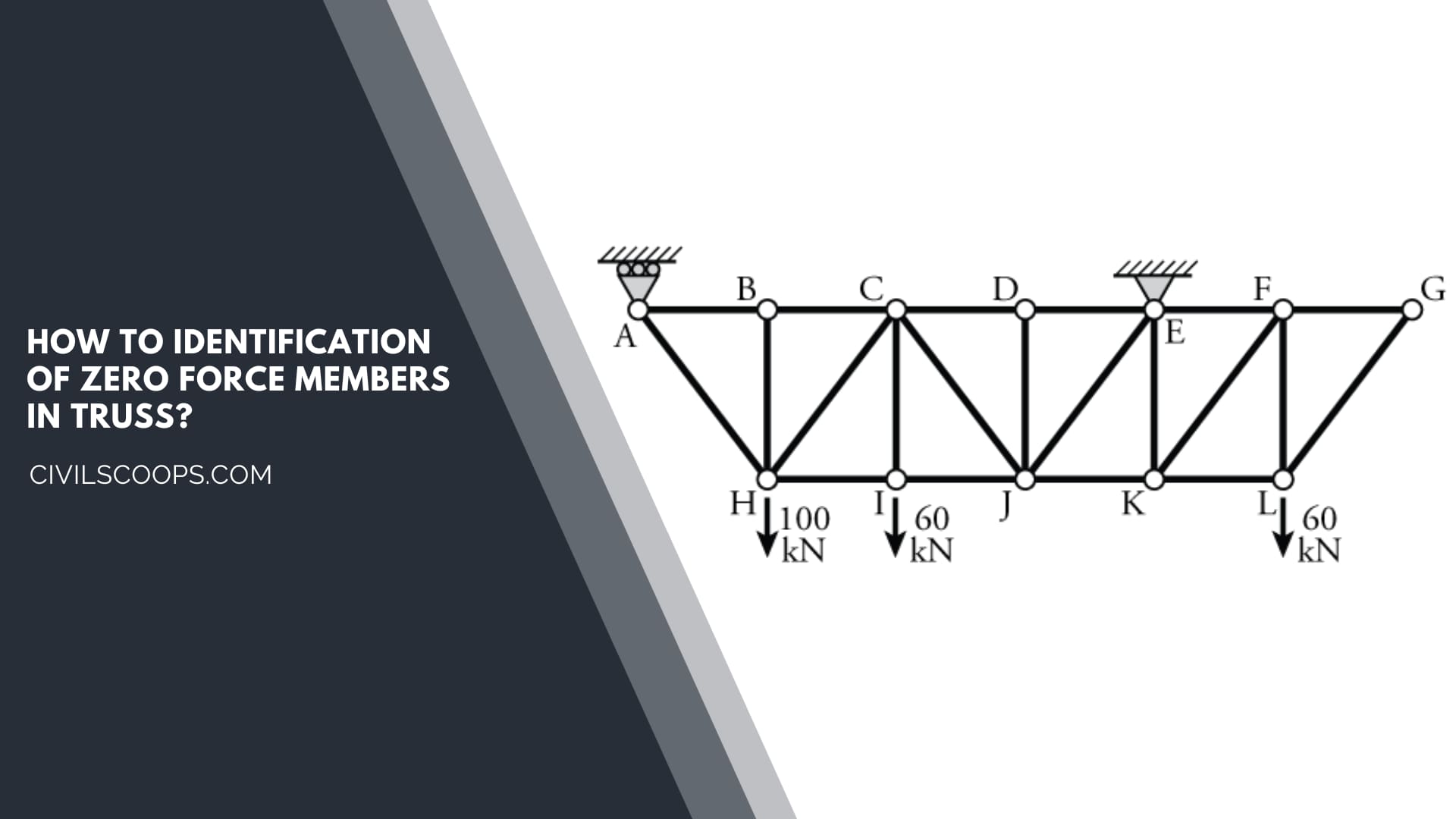
Because trusses are usually designed to support several different loading conditions, it is not uncommon to find members with zero forces in them when a truss is being analyzed for a particular loading condition.
Zero-force members are also added to trusses to brace compression members against buckling and slender tension members against vibrating.
The analysis of trusses can be expedited if we can identify the zero-force members by inspection.
Two common types of member arrangements that result in zero-force members are the following:
Also Read: How to Reduce Construction Cost (Tips)
Step – 1. Noncollinear Members
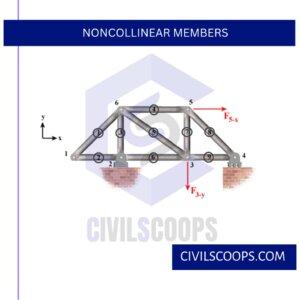
If only two noncollinear members are connected to a joint that has no external loads or reactions applied to it, then the force in both members is zero.
Step – 2. Collinear Member
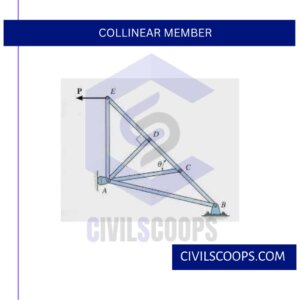
If three members, two of which are collinear, are connected to a joint that has no external loads or reactions applied to it, then the force in the member that is not collinear is zero.
[su_box title=”FAQ” style=”default” box_color=”#333333″ title_color=”#FFFFFF” radius=”3″ class=”” id=””]
Zero Force Members
If a joint has only two non-collinear members and there is no external load or support reaction at that joint, then those two members are zero- force members. In this example members DE, DC, AF, and AB are zero force members.
What Is Zero Force Member?
Zero-Force Members: structural members that support No loading but aid in the stability of the truss. Two-Force Members: structural members that are: a) subject to no applied or reaction moments, and b) are loaded only at 2 pin joints along the member.
Identify the Zero Force Members in Each Truss
If three members form a truss joint for which two of the members are collinear and there is no external load or reaction at that joint, then the third non-collinear member is a zero force member, e.g., DA.
Zero Force Member in Truss
In structural engineering and mechanics, a “zero-force member” refers to a member within a truss that carries no force, regardless of the load applied to the truss. This means that even if there are external forces acting on the truss, these members do not contribute to transferring or resisting those forces.
for This Truss Determine the Number of Zero Force Members
In a truss, a zero force member is often found at pins (any connections within the truss) where no external load is applied, and three or fewer truss members meet. Identification of basic zero force members can be accomplished by analyzing the forces acting on an individual pin in a physical system.
Zero Force Members in Truss Examples
If only two members form a truss joint and no external load or support reaction is applied to the joint, the members must be zero-force members. Member BC and CD are two non-collinear members, they share joint C. Hence, members BC and CD are zero force members.
How to Identify Zero Force Members?
Identify zero-force members in a truss by looking for joints with only two external force members or three collinear members. Additionally, consider symmetry, redundant supports, and use the method of sections if needed.
How to Identify 0 Force Members?
Identify zero-force members by looking for joints with two external force members or three collinear members. Consider symmetry, redundant supports, and use the method of sections if needed. Verify with software if available.
How to Identify Zero Force Members in a Truss?
identify the zero-force members. Solution: If three members form a truss joint and there is no external load or support reaction at that joint and two of those members are collinear then the third member is a zero-force member. Hence, DC, CF and CG are zero-force members.
Zero Force Member Rules
Rule 1: If two non-collinear members meet at an unloaded joint, then both are zero-force members. Rule 2: If three forces (interaction, reaction, or applied forces) meet at a joint and two are collinear, then the third is a zero-force member.
How to Determine Zero Force Members?
In a THREE member joint: If TWO of those members ARE parallel AND there are no other external loads (or reactions) at the joint THEN the member that is not parallel is a zero force member.
Zero Force Members in Trusses
In truss analysis, a negative member axial force implies that the member or the joints at both ends of the member are in compression, while a positive member axial force indicates that the member or the joints at both ends of the member are in tension.
Truss Zero Force Member
What Is Zero Force Member in Truss?
A zero-force member in a truss is a structural element that carries no load or force, regardless of the external loads applied to the truss. This occurs due to the specific geometric and load distribution characteristics of the truss. Zero-force members play a role in simplifying the analysis of truss structures, but they do not contribute to the overall stability or load-bearing capacity of the truss.
Member of Truss
In structural engineering, a “member” refers to an individual component or part of a larger structure, such as a truss. In the context of a truss, a member is one of the straight, rigid elements that connect the nodes (or joints) of the truss together. These members are typically made of materials like steel, wood, or other load-bearing materials.
[/su_box]
[su_note note_color=”#F2F2F2 ” text_color=”#333333″ radius=”3″ class=”” id=””]
Like this post? Share it with your friends!
Suggested Read –
- What Is Pointing
- What Is Bridge Abutment
- What Is Scrap Value and Salvage Value
- Introduction of Gantry Girder | Load on Gantry Girder
- Difference Between Flexible Pavement and Rigid Pavement
[/su_note]
Originally posted 2023-10-30 10:26:59.
